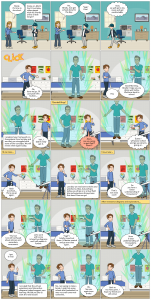My first speculative narrative was created using Pixton. It looks at education and the ability for it to be personalized for every student. As Dunne and Raby (2013) suggest, future predictions “usually take the form of scenarios, often starting with a what-if question” (p. 3). I began by thinking of what-if scenarios based on my class at school. I have a very diverse class this year, with a wide range of learning needs. I wondered what-if each student had their own teacher who could scaffold the learning and customize the experience for each student. This is where I can up with the idea of each student having their own holographic teacher, with school happening on the student’s schedule and at any location. Education would become personalized and each learner would learn at their own rate, in the environment that was best for them.

My second speculative narrative was created using Animaker. It looks at the use of technology in a student’s day to day life, but aims to show the negative social implications the technology could pose. While future technological advancements could support day-to-day life and make things easier and more personalized for man-kind, there could also be negative impacts of the technological advancements, such as a lack of social connections. I created this narrative “to draw attention to a scary possibility in the form of a cautionary tale” (Dunne and Raby, 2013, p. 28). The narrative is a something I speculate could happen and want to forewarn others about the possible implications.
(Click HERE if the video doesn’t load:
References
Dunne, A., & Raby, F. (2013). Speculative everything: design, fiction, and social dreaming. MIT press.
